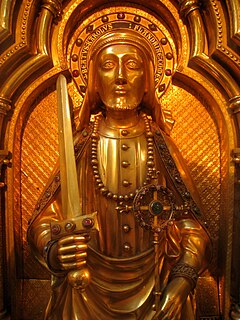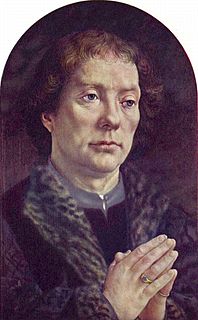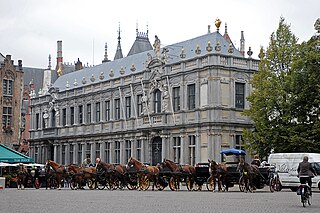
Ghent is a city and a municipality in the Flemish Region of Belgium. It is the capital and largest city of the East Flanders province, and the third largest in the country, exceeded in size only by Brussels and Antwerp. It is a port and university city.

Jan van Eyck was a painter active in Bruges who was one of the early innovators of what became known as Early Netherlandish painting, and one of the most significant representatives of Early Northern Renaissance art. According to Vasari and other art historians including Ernst Gombrich, he invented oil painting, though most now regard that claim as an oversimplification.

Charles the Good was Count of Flanders from 1119 to 1127. His murder and its aftermath were chronicled by Galbert of Bruges. He was beatified by Pope Leo XIII in 1882 through cultusconfirmation.

The Saint-Salvator Cathedral is the cathedral of Bruges, Flanders, in present-day Belgium. The cathedral is dedicated to the Verrezen Zaligmaker and Saint-Donatius of Reims.

The Groeningemuseum is a municipal museum in Bruges, Belgium, built on the site of the medieval Eekhout Abbey.

Jacobus Pamelius was a Flemish theologian who was named bishop of Saint-Omer.

Jean II Carondelet, was a Burgundian cleric, politician, jurist and one of the most important advisors to Charles V, Holy Roman Emperor. He was a patron of the Dutch philosopher Erasmus and a brother of the Habsburg diplomat Ferry Carondelet.

The Battle of Beverhoutsveld took place on 3 May 1382, on a field situated between the towns of Beernem, Oostkamp and Assebroek. It marked an important phase in the rebellion of Ghent against Louis II, Count of Flanders.

Jean-Baptiste Bethune {April 25, 1821 - June 18, 1894) was a Belgian architect, artisan and designer who played a pivotal role in the Belgian and Catholic Gothic Revival movement. He was called by some the "Pugin of Belgium", with reference to the influence on Bethune of the English Gothic Revival architect and designer, Augustus Pugin.

The Diocese of Bruges, is a Latin Church ecclesiastical territory or diocese of the Catholic Church in Belgium. It is a suffragan in ecclesiastical province of the metropolitan Archdiocese of Mechelen-Brussels, which covers all of Belgium.

St Martin's Church, also called St Martin's Cathedral, is a church and former cathedral in the Belgian city of Ypres. It was a cathedral and the seat of the former diocese of Ypres from 1561 to 1801, and is still commonly referred to as such. At 102 metres (335 ft) tall, it is among the tallest buildings in Belgium.

The Virgin and Child with Canon van der Paele is a large oil-on-oak panel painting completed around 1434–1436 by the Early Netherlandish painter Jan van Eyck. It shows the painting's donor, Joris van der Paele, within an apparition of saints. The Virgin Mary is enthroned at the centre of the semicircular space, which most likely represents a church interior, with the Christ Child on her lap. St. Donatian stands to her right, Saint George—the donor's name saint—to her left. The panel was commissioned by van der Paele as an altarpiece. He was then a wealthy clergyman from Bruges, but elderly and gravely ill, and intended the work as his memorial.

Bruges is the capital and largest city of the province of West Flanders in the Flemish Region of Belgium, in the northwest of the country, and the sixth-largest city of the country by population.

Male Castle, Bruges. A community of the Canonesses Regular of the Holy Sepulchre. It originated in Bruges in the 11th century, and between 1954 and 2013 was settled in Male Castle in Male, Sint-Kruis, Bruges, West Flanders, Belgium.
The following is a timeline of the history of the municipality of Bruges, Belgium.

Joris van der Paele or Georgius de Pala was a scribe in the papal chancery, a successful career ecclesiastic, and a patron of the painter Jan van Eyck.

The Madonna of Jan Vos is a small oil panel painting begun by the Early Netherlandish artist Jan van Eyck c. 1441 and finished by his workshop after his death in 1442. As he died during its completion, it is generally considered to be his last work.

The Provostry of St. Donatian is a Baroque building on the Burg Square in Bruges, Belgium. Built in the 17th century, it served as the headquarters of the ecclesiastical seigniory of St. Donatian.

Burg Square is a square and former fortress in Bruges. It is one of the main squares of the city.


















